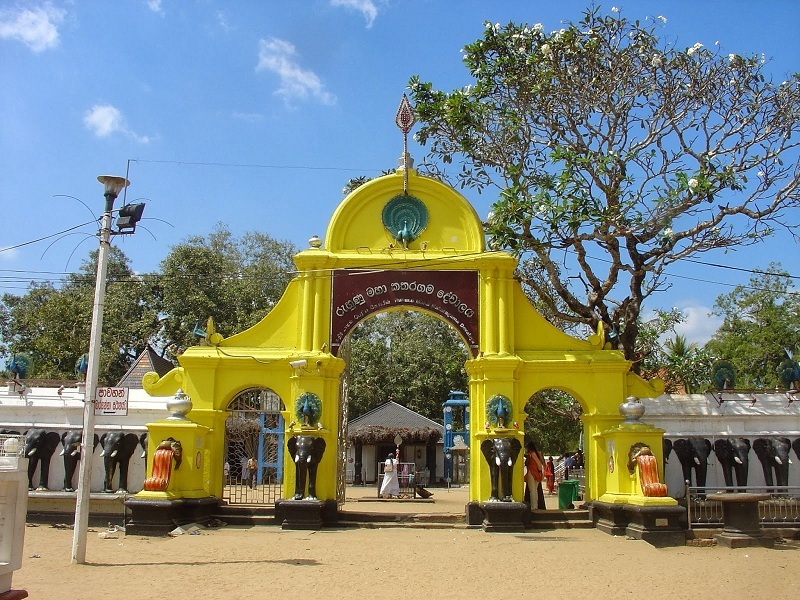Kataragama, Yala National Park - Timings, Festivals, History, Darshan, Pooja Timings
 Distance (From Yala National Park): 38 Kms
Distance (From Yala National Park): 38 Kms
 Trip Duration (Including Travel): 2 Hours
Trip Duration (Including Travel): 2 Hours
 Place Location: Sithulpawwa (17 Km)
Place Location: Sithulpawwa (17 Km)
 Transportation Options: Bus / Cab
Transportation Options: Bus / Cab
 Travel Tips: None
Travel Tips: None
At a distance of 20 km from Tissamaharama and 38 km from Yala, Kataragama is a sacred town in Sri Lanka. It is one of the most significant pilgrimages in Sri Lanka and is regarded as one of the best places to visit in Yala.
This small town is famous for Kataragama temple, a temple complex dedicated to Buddhist guardian deity Kataragama deviyo and Hindu War God Murugan. It is one of the few religious sites in Sri Lanka that is venerated by the Buddhists, Hindus, Muslims and the Vedda people. For most of the past millennia, it was a jungle shrine very difficult to access but today it is accessible by an all-weather road. The shrines and the nearby Kiri Vehera are managed by Buddhists while the shrines dedicated to Teyvanai and Shiva are managed by Hindus and the mosque by Muslims.
According to Hindus and some Buddhist texts, the main shrine is dedicated to Kartikeya. Kartikeya, also known as Kumara, Skanda, Saravanabhava, Murugan, Visakha or Mahasena, is the chief of warriors of celestial Gods. In Sri Lanka, the Sinhala Buddhists also worshiped Kartikeya as Kumara devio or Skanda-Kumara since at least the 4th century, if not earlier. Skanda-Kumara was known as one of the guardian deities until the 14th century, invoked to protect the island. During the 11th and 12th century CE, the worship of Skanda-Kumara was documented even among the royal family.
Dates back to 2nd century BC, the sanctum sanctorum of the main Kataragama temple dedicated to Lord Murugan does not have a statute of the deity instead it holds a Yantra. Of all the shrines in the complex, it is the largest and the first that all pilgrims come to visit. Although it does not have a representation of the deity, kept in an adjoining room is a statue of Shiva also known amongst Sinhalese as Karanduva. To the left of the main shrine lies a smaller shrine dedicated to Hindu god Ganesha who is known as Ganapati devio amongst Sinhalese. It too is a small rectangular building without any decoration. Vishnu Devale situated to the left of the Ganesha shrine and one can see a Buddha image here. Behind this is a large Bo tree that tradition holds as sprung from the sapling of the original Bo tree in Anuradhapura, hence is very much held in high esteem by the visiting Buddhists.
Attached to the western wall of the shrine complex are shrines dedicated to Kali, Pattini, Managara devio, Dedimunda, and Suniyam. Outside the temple yard and beyond the northern gate lies the shrine to Teyvanai, the consort of Murugan. Teyvanai shrine is managed by the Sankara Mutt from Sringeri in Karnataka, India. The shrine dedicated to Valli, the consort of the main deity lies in front of the mosque. Close to the Valli shrine is a Kadamba tree that is sacred to Murugan. Within the mosque are a number of tombs of Muslim holy men. There is also a separate shrine dedicated to the tomb of Kalayangiri Swamy known amongst Tamils as Mutuligaswamy kovil. It is also known as the Siva Devale.
The annual Esela Perehera held in July or August is the main event of the shrine. About 45 days before the festival begins, the priests go into the forest and find two forked branches of a sacred tree. The branches are then immersed in the local river and kept at the shrines dedicated to Kataragama deviyo and Valli. When the main festival begins, the Yantra representing the deity is retrieved from its storage location, paraded through a street on top of an elephant, and carried to the Valli shrine. After two hours it is returned. On the last day of the festival, the Yantra is left overnight at the Valli shrine and brought back to the main shrine. The priests conduct the rituals in silence, covering their mouths with a white cloth. Associated with the main festival is fire walking arranged by a master of the ritual. Hundreds of devotees participate in fire walking, yet others participate in ecstatic dance forms called Kavadi and body piercing. Many of the pilgrims exhibit signs of being possessed.
Another major attraction of Kataragama is the Buddhist stupa Kiri Vehera, also known as 'milk stupa', which was built around 6th BC. The stupa is said to have been built by King Mahasena, a regional ruler of the Kataragama area in the 6th Century. The stupa is 95feet in height and has a circumference of 800m is a peaceful place visited by many Buddhists to meditate. It is one of the sixteen sacred places which had been visited by Buddha Shakyamuni. The Kiri Vehera depicts a beautiful relationship between Hinduism and Buddhism. The relationship between Buddha Shakyamuni and Lord Murugan facilitated a peaceful coexistence between Buddhist and Hindu devotees in the region.
Kataragama Temple Timings: 9 AM - 8 PM












